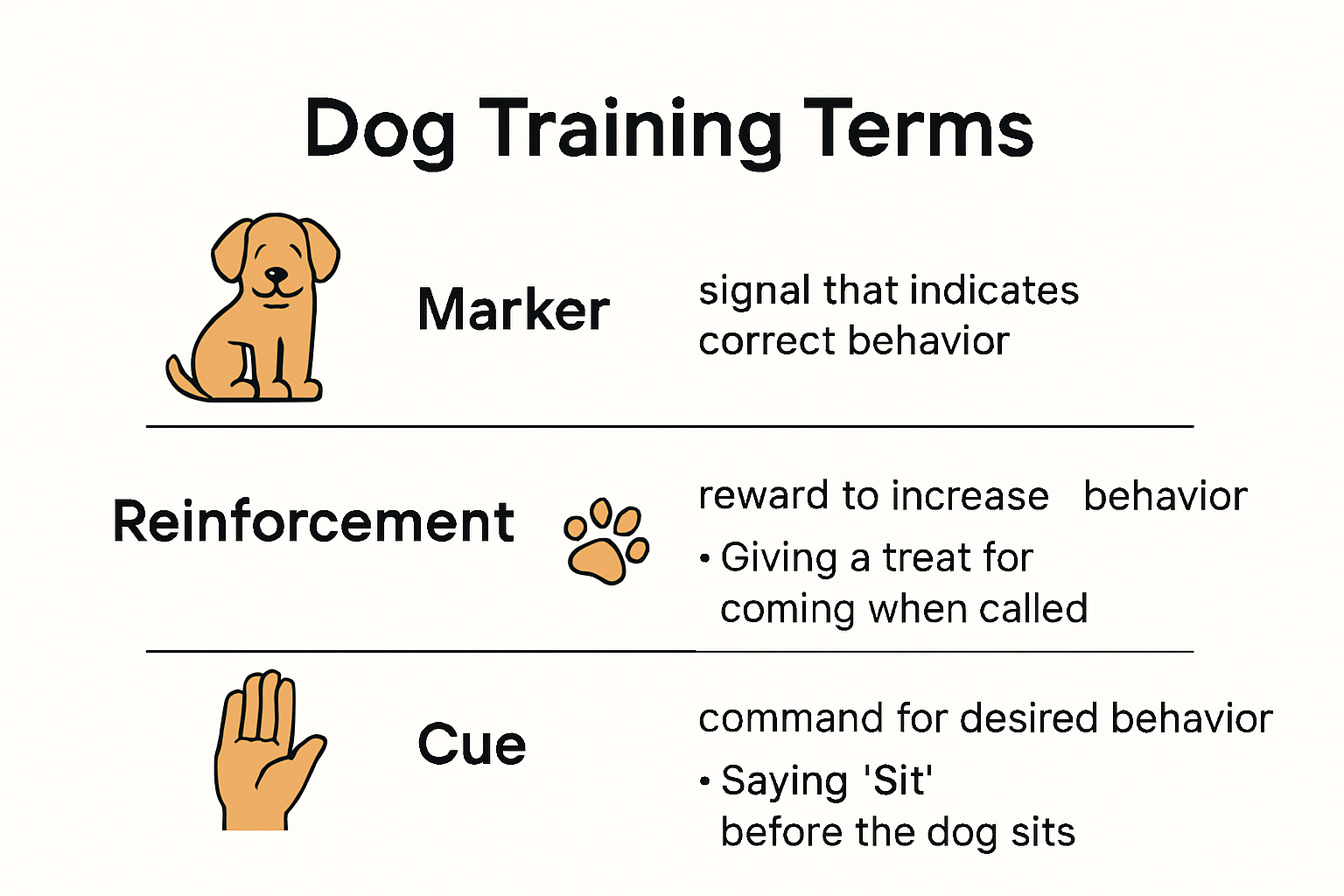
Ever wonder why some dogs seem to understand every word you say, while others look at you like you’re speaking another language? Here’s what’s surprising. Research shows that dogs trained with clear, consistent commands are up to 90 percent more reliable in following instructions. Most pet owners think it’s all about repetition or treats, but the real secret is learning the right dog training terms. Get ready to discover why knowing these words could completely change how you and your dog communicate.
Table of Contents
- Understanding Essential Dog Training Terms
- Key Commands And Their Meanings Explained
- Positive Reinforcement And Correction Methods
- How Knowing These Terms Helps Different Dog Owners
Quick Summary
| Takeaway | Explanation |
|---|---|
| Understanding Key Terminology Enhances Training | Familiarity with essential dog training terms improves communication between owners and their dogs, leading to more effective training outcomes. |
| Positive Reinforcement is Central to Effective Training | Rewarding desired behaviors fosters trust and promotes better relationship dynamics, compared to traditional correction methods which can cause fear and anxiety. |
| Command Mastery is Fundamental for Obedience | Key commands like ‘Sit,’ ‘Stay,’ and ‘Come’ form the basis of effective dog training, establishing clear communication and behavioral control. |
| Tailored Approaches for Different Owners | Recognizing specialized needs based on owner circumstances—such as service dog handlers or rescue dog owners—enables more effective training tailored to unique challenges. |
| Shared Language Bridges Gaps with Professionals | Understanding dog training terminology allows for better communication with veterinarians and trainers, ensuring effective treatment plans and behavioral interventions. |
Understanding Essential Dog Training Terms
Dog training is a complex world of communication and behavior modification that requires pet owners to understand specific terminology. Mastering these essential dog training terms helps create clearer communication between you and your canine companion, transforming your training approach from guesswork to strategic interaction.
The Language of Canine Learning
Understanding dog training terminology is more than memorizing words it is about comprehending the underlying principles of how dogs learn and respond to training. Learn more about foundational training techniques to build a stronger connection with your pet.
Operant conditioning forms the backbone of modern dog training. According to American Kennel Club, this learning process involves influencing behaviors through consequences. Dogs naturally learn by associating actions with specific outcomes, whether positive or negative. For instance, when a dog receives a treat after sitting on command, they are more likely to repeat that behavior in the future.

Core Behavioral Modification Concepts
Several key terms define how dogs learn and modify their behaviors. Positive reinforcement stands out as a critical approach, where desired behaviors are encouraged through rewards. Veterinary experts from VetStreet explain that this method involves offering treats, praise, or play when a dog performs a desired action, creating a powerful motivation for future compliance.
Extinction represents another fascinating concept in dog training. This process involves gradually eliminating an undesired behavior by consistently refusing to reinforce it. When a dog realizes that a specific action no longer produces the expected response, they will naturally reduce or stop that behavior.
Professional Training Terminology
Professional dog trainers utilize specific language that might seem complex to new pet owners. Terms like marker training refer to using a distinct sound or word to precisely mark the exact moment a dog performs a correct behavior. Shaping describes the process of gradually teaching a complex behavior by rewarding smaller, incremental steps toward the final desired action.
Understanding these essential dog training terms empowers pet owners to communicate more effectively with their dogs. By learning the language of canine behavior modification, you create a foundation for more meaningful and successful training interactions. Whether you are working with a new puppy or addressing behavioral challenges in an older dog, these terms provide the framework for building a strong, positive relationship based on mutual understanding and respect.
Below is a table summarizing key dog training concepts and their definitions. This helps clarify important terminology used throughout effective dog training:
| Term | Definition |
|---|---|
| Positive Reinforcement | Encouraging desired behaviors by offering rewards like treats, praise, or play |
| Extinction | Gradually eliminating an undesired behavior by consistently not rewarding it |
| Marker Training | Using a distinct sound or word (like a clicker or “yes”) to precisely indicate the correct behavior |
| Shaping | Rewarding small steps toward a complex behavior, gradually building up to the final action |
| Negative Reinforcement | Removing an unpleasant stimulus to increase the likelihood of a behavior |
| Positive Punishment | Adding an unpleasant consequence to reduce an unwanted behavior |
| Counter-Conditioning | Changing a dog’s emotional response to a stimulus by associating it with something positive |
| Desensitization | Gradually exposing the dog to a trigger at a low intensity to reduce sensitivity or fear |
Key Commands and Their Meanings Explained
Dog training commands are more than just words they are a critical communication system between you and your canine companion. Understanding the precise meaning and proper execution of key commands can transform your relationship with your dog, creating a foundation of mutual understanding and respect.
Basic Obedience Commands
Sit represents the most fundamental command in dog training. Hudson Animal Hospital explains that this command serves multiple purposes beyond simple obedience. It helps control your dog in potentially chaotic situations, provides a moment of focus, and acts as a gateway to more advanced training techniques. When a dog learns to sit on command, they demonstrate impulse control and attentiveness.
The Stay command is equally crucial for safety and control. This instruction teaches dogs to remain in a specific position until released, which can prevent dangerous situations like darting into traffic or approaching unfriendly animals. Professional dog trainers recommend starting with short durations and gradually increasing the time and distance to build reliable stay behavior.

Advanced Movement Commands
Heel is a sophisticated command that goes beyond simple walking. According to The Pets Magazine, this command teaches dogs to walk precisely beside their owner, maintaining a consistent position and pace. This skill is particularly valuable in crowded environments or during structured walks where close control is essential.
The Come command can be a lifesaver in potentially dangerous situations. American Kennel Club experts emphasize that a reliable recall can prevent accidents and potentially save your dog’s life. This command requires consistent practice and positive reinforcement to ensure the dog will return immediately when called, regardless of distractions.
Specialized Behavioral Commands
Leave it is a powerful command that teaches dogs to ignore potentially dangerous or unwanted objects. This instruction can prevent dogs from picking up harmful items, eating something toxic, or engaging with dangerous substances. Professional trainers suggest starting this training in controlled environments with low-value items and gradually increasing complexity.
The Down command represents more than just a physical position it signals complete submission and calm behavior. Canine behavior specialists note that this command helps establish your leadership and provides a way to manage your dog’s energy in various situations.
Mastering these key commands requires patience, consistency, and understanding. Each command is a building block in communication, creating a language that bridges the gap between human intention and canine comprehension. By investing time in precise command training, you develop not just an obedient dog, but a responsive and connected companion who understands and trusts your guidance.
Here is a table summarizing the main dog training commands explained in this section and their purpose. This quick reference can help you recall what each command achieves:
| Command | Purpose/Benefit |
|---|---|
| Sit | Helps with impulse control, focus, and sets the foundation for other commands |
| Stay | Keeps dog in position for safety and control |
| Heel | Teaches dog to walk closely at owner’s side for control in structured settings |
| Come | Ensures reliable recall, important for safety and avoiding danger |
| Leave it | Prevents dog from interacting with unwanted or dangerous items |
| Down | Promotes calmness and submission; helps manage energy |
Positive Reinforcement and Correction Methods
Dog training is a nuanced field where the methods used can profoundly impact a dog’s behavior, psychological well-being, and the human-animal bond. Understanding the difference between positive reinforcement and traditional correction methods is crucial for effective and humane training.
The Science of Positive Reinforcement
Explore the fundamentals of canine learning to understand why positive reinforcement is so powerful. According to a comprehensive review published in Science Direct, 17 studies have conclusively shown that aversive training methods can compromise both the physical and mental health of dogs. Positive reinforcement emerges as the gold standard, focusing on rewarding desired behaviors rather than punishing unwanted ones.
Research demonstrates that dogs trained with reward-based methods exhibit significantly different behavioral responses compared to those subjected to aversive techniques. A groundbreaking study found that dogs trained using rewards displayed more relaxed body language and maintained better eye contact with their owners, indicating a stronger, more trusting relationship.
Understanding Correction Approaches
Traditional correction methods often involve punishment or intimidation, which can lead to unintended psychological consequences. Research from the National Institutes of Health revealed that dogs trained with multiple aversive methods exhibit a more negative mood state. This is measurable through cognitive bias tests, where dogs show slower responses to ambiguous stimuli, suggesting increased stress and anxiety.
Negative reinforcement and positive punishment techniques, which involve removing an unpleasant stimulus or adding an unpleasant consequence, can create fear and mistrust. These methods might temporarily suppress behavior but do not address the underlying reasons for the dog’s actions.
Effective Positive Training Strategies
Positive reinforcement involves rewarding desired behaviors with treats, praise, play, or other motivating stimuli. This approach not only encourages the dog to repeat good behaviors but also builds a foundation of trust and communication. Key strategies include:
- Timing: Reward the dog immediately after the desired behavior
- Consistency: Ensure all family members use the same training approach
- Gradual progression: Start with simple commands and slowly increase complexity
The goal of positive reinforcement is to make learning an enjoyable experience for the dog. By focusing on what the dog does right and providing clear, consistent feedback, trainers can shape behavior more effectively than through punishment.
Choosing the right training method is about more than just teaching commands it is about building a relationship based on mutual respect, understanding, and trust. Positive reinforcement transforms training from a series of instructions into a collaborative journey of communication and bonding.
To help clarify the core differences and effects of positive reinforcement versus correction (aversive) methods, the table below summarizes their characteristics as discussed in the article:
| Method | Description | Effects on Dog |
|---|---|---|
| Positive Reinforcement | Rewarding desired behaviors with treats, praise, or play | Builds trust, increases learning, promotes relaxation and good relationship |
| Negative Reinforcement | Removing something unpleasant after a behavior | Can cause fear, mistrust; risks increasing anxiety |
| Positive Punishment | Adding an unpleasant consequence to discourage a behavior | May suppress unwanted actions but increases stress and fear |
| Aversive Methods (General) | Use of punishment/intimidation to stop behavior | Linked to negative moods, slower learning, harm to physical/mental health |
How Knowing These Terms Helps Different Dog Owners
Dog training terminology is not just academic jargon it is a powerful communication toolkit that empowers different types of dog owners to understand, train, and connect with their canine companions more effectively. Explore advanced training strategies to enhance your understanding of dog behavior and learning.
Specialized Needs for Different Owner Groups
Each dog owner brings unique circumstances and challenges to their training journey. Research from FOUR PAWS International highlights that understanding associative learning principles is fundamental for effective training across various owner scenarios.
Service dog handlers require precise communication and command understanding. Terms like task training and public access skills become critical for these owners. Knowing exactly how to describe and reinforce specific behaviors helps service dogs perform complex tasks with reliability and consistency.
Rescue dog owners face unique challenges with dogs that might have experienced trauma or inconsistent training. Understanding terms such as desensitization and counter-conditioning becomes crucial in helping these dogs overcome past negative experiences and build trust in their new environments.
Addressing Specific Training Challenges
A study from the Cummings School of Veterinary Medicine emphasizes that positive reinforcement-based training enhances the human-animal bond by fostering trust and mutual understanding. Senior pet owners and individuals with limited mobility benefit immensely from understanding precise training terminology.
For instance, target training allows owners with physical limitations to teach dogs complex behaviors using minimal physical movement. This technique enables communication through consistent, clear signals rather than demanding physical interactions.
Communication and Medical Understanding
Medical research published in the Journal of Veterinary Behavior reveals that pet owners often misunderstand technical terms, which can lead to communication gaps with veterinarians and trainers. Understanding dog training terminology bridges this knowledge divide.
Terms like prognosis, behavioral modification, and conditioning help owners communicate more effectively with professionals. This shared language ensures that treatment plans, training strategies, and behavioral interventions are understood and implemented correctly.
Knowing these essential dog training terms transforms the relationship between dogs and their owners. It creates a shared language of understanding, respect, and communication. Whether you are a first-time puppy owner, a service dog handler, or caring for a rescue dog, these terms provide the keys to unlocking more meaningful, effective, and compassionate training experiences.
By investing time in learning this specialized vocabulary, owners become more than just caretakers they become true partners in their dogs’ learning and development. The right words can quite literally open up new worlds of connection and mutual understanding.
Frequently Asked Questions
What are some essential dog training terms every pet owner should know?
Understanding terms like positive reinforcement, marker training, and shaping can greatly enhance communication and training effectiveness between you and your dog.
How does positive reinforcement work in dog training?
Positive reinforcement involves encouraging desired behaviors by rewarding dogs with treats, praise, or play, which helps build trust and promotes better relationships.
Why is knowing dog training terminology important for communication with professionals?
Familiarity with dog training terms like behavioral modification and conditioning helps pet owners communicate effectively with veterinarians and trainers, ensuring successful training and treatment.
What are basic obedience commands I should teach my dog?
Key commands include Sit, Stay, Come, Leave it, and Down. These commands form the foundation for effective training, promoting safety and good behavior.
Unlock Real Communication With Your Dog: Transform Training Into Safety And Independence
Learning foundational dog training terms is only the first step. Have you ever wished your dog could truly tell you what they need, not just respond to commands but also send you a clear signal when it matters most? Many pet owners face frustration when safety or independence is at stake, especially those living alone or caring for dogs with special responsibilities. Mastering concepts such as positive reinforcement and marker training is powerful, but giving your dog a way to communicate back opens up a whole new level of trust and security.

Imagine your dog pressing a simple button to alert you. The iPupPee device makes this possible, bridging the gap between essential training terms and real-world communication. Whether you are training a service dog, supporting a senior, or helping a rescue dog build confidence, our innovative solution brings safety and understanding to your routine. Ready to give your dog a voice and see how true two-way communication can change your daily life? Visit ipuppee.com now to discover how the iPupPee device empowers every dog owner. Do not miss this chance to turn your training knowledge into genuine independence and peace of mind.
Recommended
-
https://ipuppee.com/blogs/news/how-to-teach-dogs-basic-commands)
-
https://ipuppee.com/blogs/news/dog-training-problems-solutions-for-every-owner)
-
https://ipuppee.com/blogs/news/expert-dog-obedience-training)
-
https://ipuppee.com/blogs/news/training-techniques-for-dogs-guide-owners-handlers-2025)
-
https://ipuppee.com/blogs/news/smart-dog-training-tips-2025-guide)
-
https://ipuppee.com/blogs/news/dog-behavioral-training-guide-2025)

